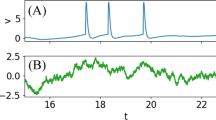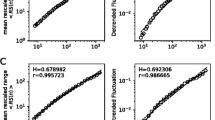Abstract
We review and extend recent results on the instantaneous firing rate dynamics of simplified models of spiking neurons in response to noisy current inputs. It has been shown recently that the response of the instantaneous firing rate to small amplitude oscillations in the mean inputs depends in the large frequency limit f on the spike initiation dynamics. A particular simplified model, the exponential integrate-and-fire (EIF) model, has a response that decays as 1/f in the large frequency limit and describes very well the response of conductance-based models with a Hodgkin-Huxley type fast sodium current. Here, we show that the response of the EIF instantaneous firing rate also decays as 1/f in the case of an oscillation in the variance of the inputs for both white and colored noise. We then compute the initial transient response of the firing rate of the EIF model to a step change in its mean inputs and/or in the variance of its inputs. We show that in both cases the response speed is proportional to the neuron stationary firing rate and inversely proportional to a ‘spike slope factor’ Δ T that controls the sharpness of spike initiation: as 1/Δ T for a step change in mean inputs, and as 1/Δ T 2 for a step change in the variance in the inputs.
Similar content being viewed by others
References
Anderson JS, Lampl I, Gillespie DC, Ferster D (2000) The contribution of noise to contrast invariance of orientation tuning in cat visual cortex. Science 290: 1968–1972.
Brunel N, Chance F, Fourcaud N, Abbott L (2001) Effects of synaptic noise and filtering on the frequency response of spiking neurons. Phys. Rev. Lett. 86: 2186–2189.
Brunel N, Hakim V, Richardson M (2003) Firing rate resonance in a generalized integrate-and-fire neuron with subthreshold resonance. Phys. Rev. E 67: 051916.
Brunel N, Latham P (2003) Firing rate of noisy quadratic integrate-and-fire neurons. Neural Comput. 15: 2281–2306.
Brunel N, Sergi S (1998) Firing frequency of integrate-and-fire neurons with finite synaptic time constants. J. Theor. Biol. 195: 87–95.
Destexhe A, Paré D (1999) Impact of network activity on the integrative properties of neocortical pyramidal neurons in vivo. J. Neurophysiol. 81: 1531–1547.
Ermentrout B (1998) Linearization of F-I curves by adaptation. Neural Comput 10: 1721–1729.
Ermentrout B, Pascal M, Gutkin B (2001) The effects of spike frequency adaptation and negative feedback on the synchronization of neural oscillators. Neural Comput. 13: 1285–310.
Ermentrout GB (1996) Type I membranes, phase resetting curves, and synchrony. Neural Comput. 8: 979–1001.
Ermentrout GB, Kopell N (1986) Parabolic bursting in an excitable system coupled with a slow oscillation. SIAM J. Appl. Math. 46: 233–253.
Fourcaud N, Brunel N (2002) Dynamics of firing probability of noisy integrate-and-fire neurons. Neural Comput. 14: 2057–2110.
Fourcaud-Trocme’ N, Hansel D, van Vreeswijk C, Brunel N (2003) How spike generation mechanisms determine the neuronal response to fluctuating inputs. J. Neurosci. 23: 11628–11640.
Fuhrmann G, Markram H, Tsodyks M (2002) Spike frequency adaptation and neocortical rhythms. J. Neurophysiol. 88: 761–770.
Gerstner W (2000) Population dynamics of spiking neurons: Fast transients, asynchronous states, and locking. Neural Comput. 12: 43–89.
Gerstner W, Kistler WM (2002) Spiking Neuron Models: Single Neurons, Populations, Plasticity. Cambridge University Press.
Gutkin B, Ermentrout GB (1998) Dynamics of membrane excitability determine interspike interval variability: A link between spike generation mechanisms and cortical spike train statistics. Neural Comp. 10: 1047–1065.
Hansel D, Mato G (2003) Asynchronous states and the emergence of synchrony in large networks of interacting excitatory and inhibitory neurons. Neural Comp. 15: 1–56.
Izhikevich EM (2001) Resonate-and-fire neurons. Neural Networks 14: 883–894.
Izhikevich EM (2003) Simple model of spiking neurons. IEEE Transactions on Neural Networks 14: 1569–1572.
Knight BW (1972) Dynamics of encoding in a population of neurons. J. Gen. Physiol. 59: 734–766.
Koendgen H, Geisler C, Wang XJ, Fusi S, Luescher HR, Giugliano M (2004) The dynamical response of single cells to noisy time-varying currents. In: Society for Neuroscience Abstracts, pp. 640.9.
La Camera G, Rauch A, Luscher HR, Senn W, Fusi S (2004) Minimal models of adapted neuronal responses to in-vivo like input currents. Neural Comp. 16: 2101–2124.
Lapicque L (1907) Recherches quantitatives sur l’excitabilité électrique des nerfs traitée comme une polarisation. J. Physiol. Pathol. Gen. 9: 620–635.
Lindner B, Longtin A, Bulsara A (2003) Analytic expressions for rate and CV of a type I neuron driven by white gaussian noise. Neural Comp. 15: 1760–1787.
Lindner B, Schimansky-Geier L (2001) Transmission of noise coded versus additive signals through a neuronal ensemble. Phys. Rev. Lett. 86: 2934–2937.
Moreno R, Parga N (2004) Role of synaptic filtering on the firing response of simple model neurons. Phys. Rev. Lett. 92: 028102.
Naundorf B, Geisel T, Wolf F (2003) How fast can a neuron react to transient stimuli? preprint, xxx.lanl.gov, physics/0307135.
Naundorf B, Geisel T, Wolf F (2004) Action potential onset dynamics and the response speed of neuronal populations. preprint.
Rauch A, Camera GL, Lüscher H-R, Senn W, Fusi S (2003) Neocortical pyramidal cells respond as integrate-and-fire neurons to in vivo-like input currents. J. Neurophysiol. 90: 1598–1612.
Richardson M, Brunel N, Hakim V (2003) From subthreshold to firing-rate resonance. J. Neurophysiol. 89: 2538–2554.
Silberberg G, Bethge M, Markram H, Pawelzik K, Tsodyks M (2004) Dynamics of population rate code in ensemble of neocortical neurons. J. Neurophysiol. 91: 704–709.
Tateno T, Harsch A, Robinson HP (2004) Threshold firing frequency-current relationships of neurons in rat somatosensory cortex: Type 1 and type 2 dynamics. J. Neurophysiol. 92: 2283–2294.
Treves A (1993) Mean-field analysis of neuronal spike dynamics. Network 4: 259–284.
Tuckwell HC (1988) Introduction to Theoretical Neurobiology. Cambridge, University Press, Cambridge.
van Vreeswijk C, Hansel D (2001) Patterns of synchrony in neural networks with spike adaptation. Neural Comput. 13: 959–992.
Wang X-J, Buzsáki G (1996) Gamma oscillation by synaptic inhibition in a hippocampal interneuronal network model. J. Neurosci. 16: 6402–6413.
Author information
Authors and Affiliations
Corresponding author
Rights and permissions
About this article
Cite this article
Fourcaud-Trocmé, N., Brunel, N. Dynamics of the Instantaneous Firing Rate in Response to Changes in Input Statistics. J Comput Neurosci 18, 311–321 (2005). https://doi.org/10.1007/s10827-005-0337-8
Received:
Revised:
Accepted:
Issue Date:
DOI: https://doi.org/10.1007/s10827-005-0337-8




